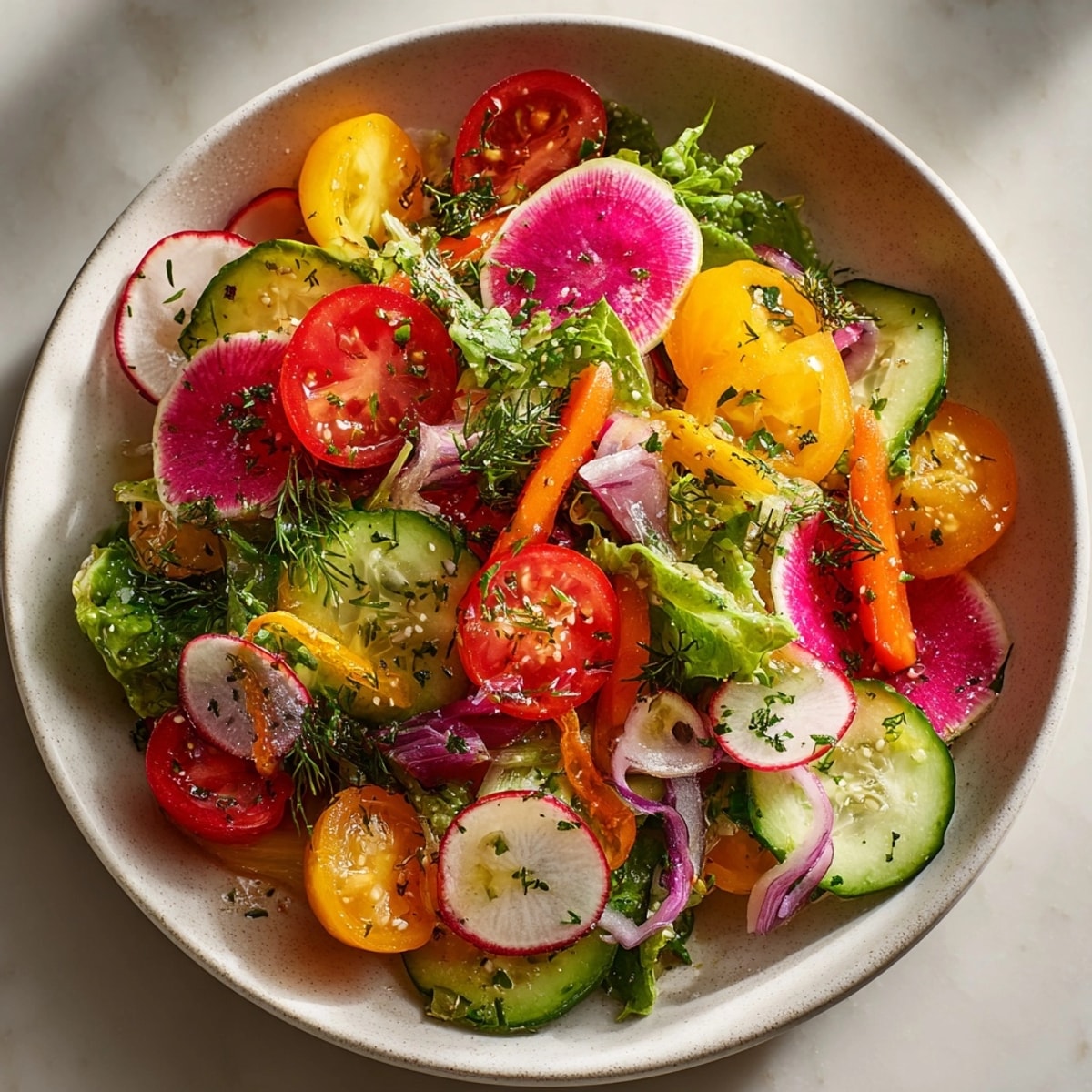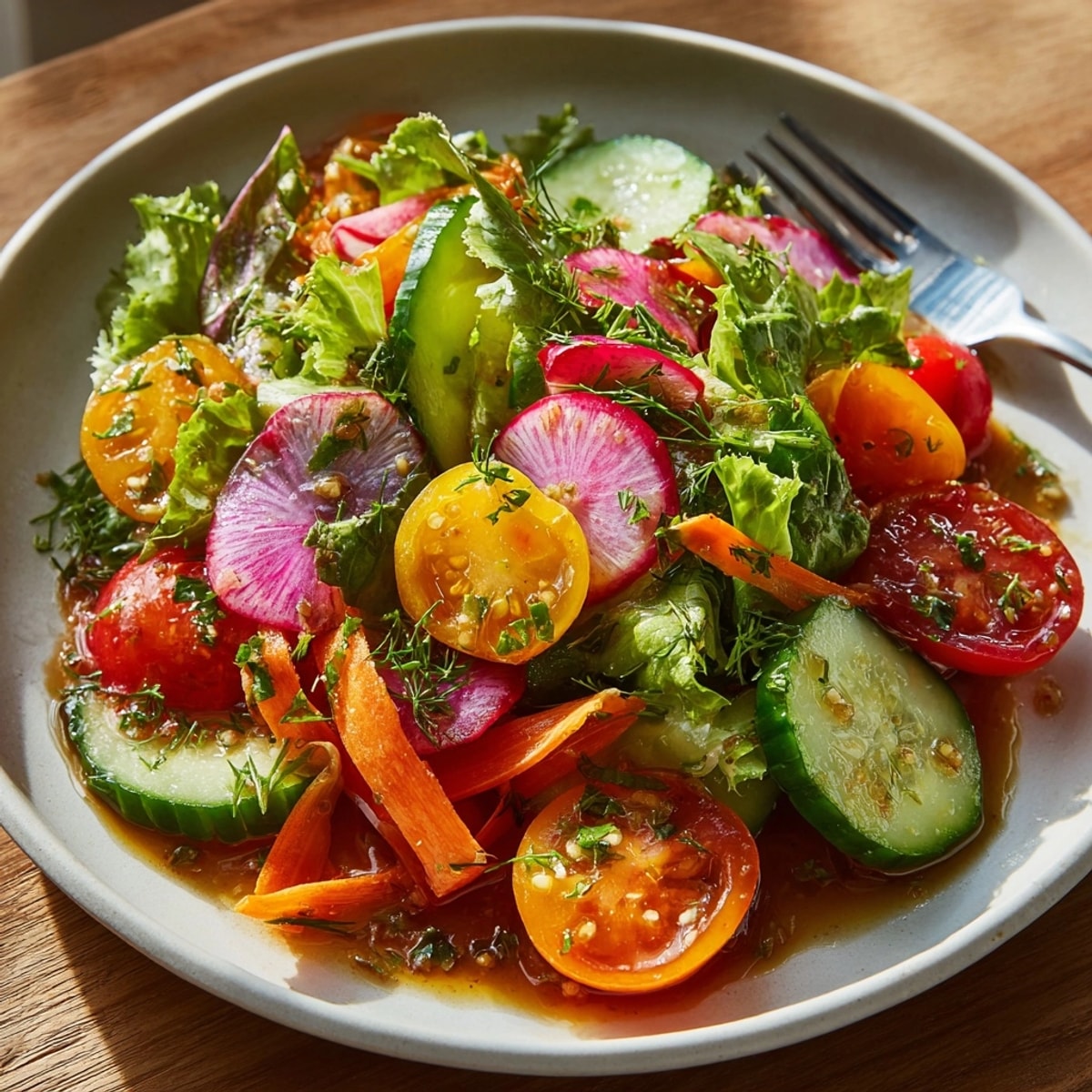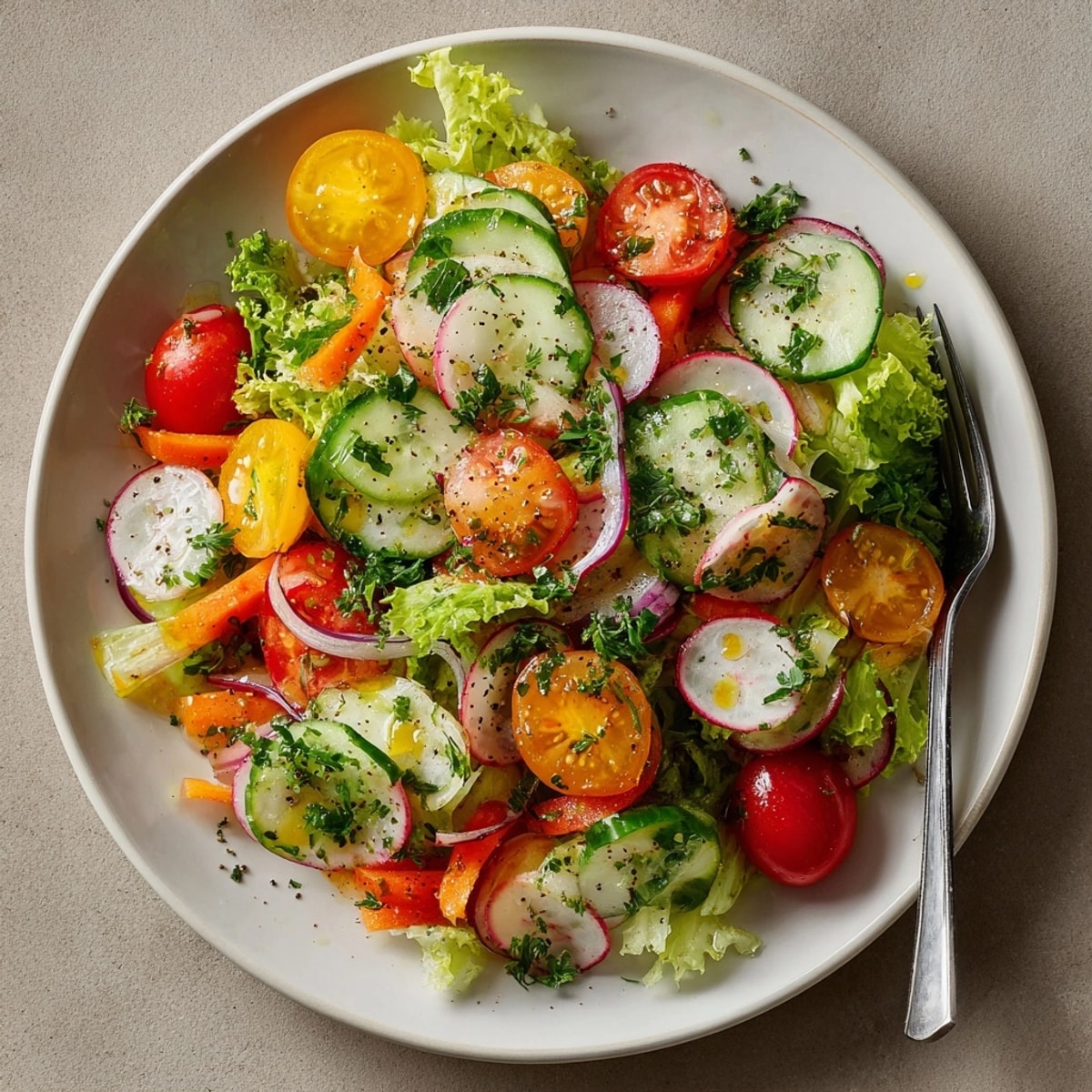 Pin
Pin This crisp and vibrant garden salad has become my summer staple for those days when I crave something refreshing yet satisfying. The unexpected pickle vinaigrette adds a tangy dimension that transforms an ordinary salad into something guests always ask about.
I first created this recipe during a particularly hot summer when turning on the stove felt unbearable. What began as a creative way to use up pickle juice has become my most requested potluck contribution.
Ingredients
- Mixed salad greens: The foundation of any good salad. I recommend a blend of peppery arugula, tender spinach, and crisp romaine for varied textures and flavors
- Cherry tomatoes: Look for ones that are bright in color and firm to the touch. The natural sweetness balances the tanginess of the dressing
- Cucumber: Provides refreshing crunch. English cucumbers work best as they have fewer seeds and thinner skin
- Red onion: Adds a gentle bite. Soak slices in cold water for 10 minutes if you prefer to mellow the sharpness
- Carrot: Brings natural sweetness and beautiful color. Choose firm carrots with vibrant orange hue
- Radishes: Offer a peppery crunch that complements the pickle dressing perfectly
- Fresh parsley: Brightens the entire dish. Always opt for the flat leaf Italian variety for more pronounced flavor
- Dill pickle juice: The secret ingredient that gives this dressing its unique character. Use juice from good quality pickles
- Extra virgin olive oil: The better the oil, the better your dressing. Look for cold pressed varieties
- White wine vinegar: Adds brightness. Rice vinegar makes a good substitute if needed
- Dijon mustard: Acts as an emulsifier while adding depth. Whole grain mustard works too but changes the texture
- Honey: Balances the acidity. Clover honey has a neutral flavor that works well here
- Chopped dill pickles: Reinforces the pickle flavor while adding texture. I prefer kosher dill for best results
- Fresh dill: Complements the pickle flavor perfectly. Dried works in a pinch but fresh delivers superior flavor
Instructions
- Prepare the vegetables:
- Wash all produce thoroughly under cold running water. Pat dry with clean kitchen towels to ensure crisp greens. Slice cherry tomatoes in half through the equator rather than pole to pole to keep seeds intact. Cut cucumber into thin half moons about 1/8 inch thick. Slice red onion as thinly as possible using a sharp knife or mandoline. Julienne carrots into thin matchsticks or use a vegetable peeler for delicate ribbons. Cut radishes into thin coins to showcase their beautiful interior pattern. Roughly chop parsley, discarding tough stems.
- Assemble the salad base:
- In your largest salad bowl, gently layer the greens first, followed by all other prepared vegetables. The key is to distribute ingredients evenly rather than mixing aggressively which can bruise delicate greens. Leave room at the top of the bowl for tossing once the dressing is added.
- Create the pickle vinaigrette:
- In a small bowl or mason jar, combine pickle juice, olive oil, vinegar, Dijon, and honey if using. Whisk vigorously until emulsified and slightly thickened, about 30 seconds. Alternatively, seal the jar and shake vigorously. Add the chopped pickles and fresh dill, then season with salt and pepper. Remember that pickle juice contains salt already, so taste before adding more.
- Dress and serve:
- Just before serving, drizzle approximately three quarters of the dressing over the salad. Using two large spoons or salad servers, gently toss from the bottom up, folding rather than stirring to coat everything evenly without crushing the ingredients. Add more dressing if needed. Serve immediately to maintain optimal crispness and texture.
 Pin
Pin 
The pickle vinaigrette is truly what makes this salad special. I stumbled upon this combination when trying to reduce food waste in my kitchen. My grandmother always kept pickle juice for various uses, from tenderizing meat to soothing sunburns, but adding it to salad dressing has proven to be my favorite application. The bright acidity paired with the herbal notes creates a flavor profile that keeps people guessing.
Seasonal Adaptations
Summer version shines with the addition of fresh peaches or nectarines, which provide a sweet contrast to the tangy dressing. The natural sugars in stone fruits caramelize beautifully when grilled briefly before adding to the salad.
Fall adaptation
Fall adaptation works wonderfully with roasted cubes of butternut squash and a handful of dried cranberries. The earthy sweetness of autumn vegetables stands up perfectly to the zippy dressing.
Winter remix
Winter remix incorporates sturdy greens like kale massaged with a bit of the dressing, topped with citrus segments and avocado. The vitamin C boost comes at the perfect time during cold and flu season.
Make It A Meal
This vibrant salad transforms into a complete meal with just a few thoughtful additions. For protein, consider adding grilled chicken breast seasoned simply with salt and pepper, or wild caught salmon with its rich omega3 fatty acids. Plant based eaters might appreciate chickpeas tossed with a pinch of smoked paprika before adding to the salad, or cubes of marinated tofu.
The pickle vinaigrette pairs surprisingly well with grains, so adding a scoop of cooked quinoa or farro creates a more substantial offering while maintaining the refreshing qualities. For a special occasion, try adding crumbled goat cheese or blue cheese which creates a delightful creamy contrast to the crisp vegetables and tangy dressing.
I often serve this as the foundation of a "build your own" salad bar for casual gatherings, with the dressing and various protein options on the side so guests can customize to their preferences.
Storage Tips
Proper storage is crucial for maintaining the freshness of both components of this dish. For the mixed greens, wash thoroughly then wrap gently in clean kitchen towels before placing in a perforated plastic bag or container lined with paper towels. This absorbs excess moisture while allowing for some air circulation, extending the life of your greens by several days.
The pickle vinaigrette should be stored in an airtight container or mason jar in the refrigerator. The olive oil may solidify slightly when cold but will return to liquid state after sitting at room temperature for about 10 minutes. Give it a good shake or whisk before using.
For meal prep purposes, prepare all components separately and assemble just before eating. Precut vegetables like carrots, radishes and cucumbers can be stored in water in the refrigerator to maintain crispness, just drain and pat dry before adding to your salad.
 Pin
Pin The pickle vinaigrette is truly what makes this salad special. I stumbled upon this combination when trying to reduce food waste in my kitchen. My grandmother always kept pickle juice for various uses, from tenderizing meat to soothing sunburns, but adding it to salad dressing has proven to be my favorite application. The bright acidity paired with the herbal notes creates a flavor profile that keeps people guessing.
Recipe Questions & Answers
- → How can I make this salad more filling?
To make this salad more substantial, add protein like grilled chicken, salmon, hard-boiled eggs, chickpeas, or crumbled feta cheese. You can also incorporate hearty additions like quinoa, farro, or roasted sweet potatoes to transform it into a complete meal.
- → Can I prepare the pickle vinaigrette ahead of time?
Yes! The pickle vinaigrette can be prepared up to 3 days in advance and stored in an airtight container in the refrigerator. Just give it a good shake or whisk before using, as the ingredients may separate when stored.
- → What's the best substitute for dill pickle juice?
If you don't have dill pickle juice, you can substitute with apple cider vinegar or white vinegar mixed with a pinch of sugar and some dried dill. You'll miss some of the distinctive pickle flavor, but will still achieve a tangy dressing base.
- → How long will the dressed salad keep?
Once dressed, the salad is best consumed immediately as the greens will begin to wilt. If you need to prepare in advance, keep the dressing separate from the vegetables and combine just before serving. Undressed, the prepared vegetables will keep for 1-2 days in the refrigerator.
- → What makes pickle vinaigrette different from regular vinaigrette?
Pickle vinaigrette uses pickle juice as its acid component instead of just vinegar, adding complexity with its blend of vinegar, salt, garlic, dill and other pickling spices. This creates a unique tangy flavor profile with subtle briny notes that adds dimension to the salad beyond what a standard vinaigrette provides.